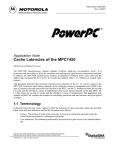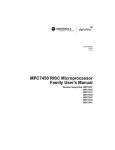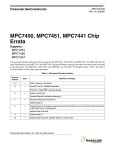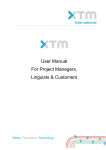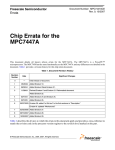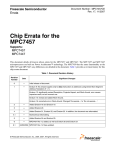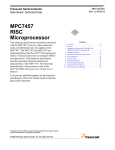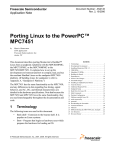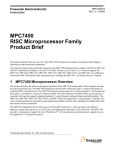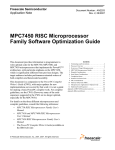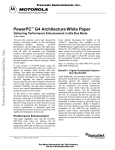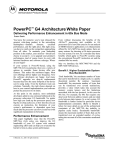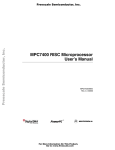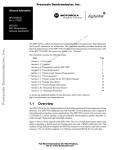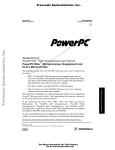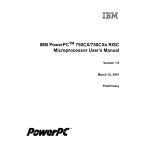Download Cache Latencies of the PowerPC MPC7451
Transcript
Freescale Semiconductor Application Note Document Number: AN2180 Rev. 2, 09/2006 Cache Latencies of the PowerPC™ MPC7451 by Bill Brock/Michael Exerman CPD Application Freescale Semiconductor, Inc. Austin, TX The MPC7450/MPC7451 microprocessor contains separate 32-Kbyte, eight-way set-associative level 1 (L1) instruction and data caches to allow the execution units and registers rapid access to instructions and data. (The MPC7451 has the same functionality as the MPC7450, and any differences in data regarding bus timing, signal behavior, and AC, DC, and thermal characteristics are detailed in the hardware specifications. Note that because the MPC7450 and MPC7451 have the same functionality, they are used interchangeably throughout the documentation and code.) In addition, the MPC7450 microprocessor features an integrated 256-Kbyte level 2 (L2) cache and the address tags and status bits for a level 3 (L3) cache that supports either 1 or 2 Mbytes of external cache memory. This application note describes the instruction and data access latencies of the L1, L2, and L3 caches for the MPC7450 microprocessor family. Note that the L3 cache is not supported by the MPC7441 or MPC7445. Instruction fetch latency depends on the instruction memory management unit (MMU), the type of execution unit and instruction, the fetch hits in the BTIC, and the L1 instruction cache, the on-chip L2 cache, and the off-chip L3 cache, if implemented. Data access latency depends on the data © Freescale Semiconductor, Inc., 2004, 2006. All rights reserved. Contents 1 Terminology. . . . . . . . . . . . . . . . . . . . . . . . . . . . . . . . . 2 2 L1 Hit Latency . . . . . . . . . . . . . . . . . . . . . . . . . . . . . . . 2 2.1 Accessing the L1 Instruction Cache . . . . . . . . . . . .2 2.2 Accessing the L1 Data Cache . . . . . . . . . . . . . . . . 2 3 L1 Miss, L2 Hit Latency . . . . . . . . . . . . . . . . . . . . . . . .3 3.1 Instruction Accesses from the L2 Cache . . . . . . . . 3 3.2 Data Accesses from the L2 Cache . . . . . . . . . . . . . 4 4 L3 Latency . . . . . . . . . . . . . . . . . . . . . . . . . . . . . . . . . . 5 4.1 Instruction Accesses from the L3 Cache . . . . . . . . 5 4.2 Data Accesses from the L3 Cache . . . . . . . . . . . . . 6 5 Revision History . . . . . . . . . . . . . . . . . . . . . . . . . . . . . 7 Terminology MMU, the L1 data cache, the on-chip L2 cache, and the off-chip L3 cache, if implemented. This application note assumes an MMU hit, explains the formulas for calculating instruction and data latencies, and gives typical examples. 1 Terminology In this document, the term ‘cache’ applies to either the instruction or data cache unless otherwise specified. Other terms and their definitions used in this document are as follows: • Latency: The number of clock cycles necessary to execute an instruction and make ready the results of that execution for a subsequent instruction. • Core arbitration: The arbitration performed by the processor to gain access to the internal address bus 2 L1 Hit Latency The following subsections describe the latencies for accessing the L1 instruction and data caches. Section 2.2, “Accessing the L1 Data Cache addresses data cache reads. For information on store accesses and the L1 data cache, see Chapter 6, “Instruction Timing,” in the MPC7450 RISC Microprocessor User’s Manual. 2.1 Accessing the L1 Instruction Cache Calculating total processor clocks required for the instruction fetch unit to request and receive instructions from the L1 instruction cache includes the following: • One cycle for MMU lookup, instruction cache tag lookup, and comparing the two • One cycle for multiplexing the lookups, some decoding of instructions, and driving the instruction from the L1 cache to the instruction queue. A maximum number of four instructions can be fetched per cycle. This two-cycle value is the best case for L1 instruction cache hit latency, calculated from a non-branching instruction, i.e., an instruction that does not branch, or a branch instruction that misses in the branch target instruction cache (BTIC). 2.2 Accessing the L1 Data Cache The data cache read hit latency is three cycles, as follows: 1. The effective address is calculated. The second half of this first cycle is the MMU translation of the effective address to the physical address and simultaneous with this is the cache tag/status information lookup. 2. The output of the MMU is compared with the tags, and this is combined with the status information to see if a hit occurs. If there is a data cache hit, the data from the selected way is read out and the data is latched at the edge of the cache. 3. The data is aligned and driven out to the rename buffers and to any other unit that is affected. Cache Latencies of the PowerPC™ MPC7451, Rev. 2 2 Freescale Semiconductor L1 Miss, L2 Hit Latency Figure 1 shows an L1 data cache read. Floating-point unit accesses require an additional cycle to forward data because alignment and driving take longer. Data must be aligned right justified to the LSB on the bus. Figure 1 applies to the fixed-point execution units and Altivec units. 3-Cycle Access Cycle 0 Cycle 1 Cycle 2 Core Clock EA1 MMU Translate1 Cache Tag Lookup Way Select Align Drive to Rename Buffer Figure 1. L1 Data Cache Access 3 L1 Miss, L2 Hit Latency If no hit occurs in the L1 cache for either an instruction or data read, the access propagates into the L1 miss queue and L1 core arbitration begins; the processor arbitrates for the internal address bus. The following sections describe instruction and data accesses in the L2 cache. 3.1 Instruction Accesses from the L2 Cache Calculation of the instruction L1 miss and L2 hit cycles includes the following factors, also summarized in Table 1: • Two cycles for L1 tag look up and miss. The actual number of cycles is one and a half, but is rounded up. • Three cycles for L1 core arbitration. This is the number of cycles required for the processor to arbitrate for the internal address bus after a miss. Note that L1 core arbitration for instruction accesses may require more than three cycles in some instances. If the core is already trying to broadcast a load, store, or castout to the memory subsystem (MSS), for example, these events could cause core arbitration to be delayed. • One cycle for the MSS arbitration to access the L2 cache. If an instruction is in the L2 cache, the MSS must arbitrate access to the L2 cache before the cache transfer can occur. Note that exceptions may cause MSS arbitration to require more than one cycle, as follows: – If the existing accesses have priority over the one in question, L2 access can be delayed. For example, if there is a prior L2 miss that is reloading from the bus, this will win arbitration and block the current arbitration from the instruction cache. – In an L2 castout operation, if there was a prior access that caused a line to be deallocated, and if that data is valid and in a block marked modified, it must be cast out of the L2 cache and written back to memory. That writeback requires arbitration and more cycles. Cache Latencies of the PowerPC™ MPC7451, Rev. 2 Freescale Semiconductor 3 L1 Miss, L2 Hit Latency • • • Three cycles for L2 tag lookup One cycle for forwarding the instruction back to the core from the MSS Three cycles for sending the instruction to the instruction queue. This includes the instruction predecode stage, forwarding the instruction back to the core, and putting the valid fetched instruction into the instruction queue. Full fetch latency is 13 cycles from fetch to arrival into the instruction queue (IQ) for an instruction cache miss/L2 cache hit. Note that the additional latency for an L1 instruction cache miss and L2 hit (compared to the two-cycle L1 hit) is 11 cycles. Table 1. L1 Instruction Cache Miss, L2 Hit Latency Cycles Cycle Number Total Cycles per Function 1, 2 2 Instruction cache latency: L1 tag lookup and miss 3, 4, 5 3 L1 core arbitration 6 1 L2 MSS arbitration 7, 8, 9 3 L2 tag lookup and hit 10 1 L2 MSS forwarding instruction back to core. Note that cycles 6 through 10 are common to any L2 cache access from the core. 11 1 Instruction pre-decode stage 12 1 Instruction forwarding 13 1 Placing valid instruction in the instruction queue 3.2 Function Reloading instruction into the L1 cache Data Accesses from the L2 Cache For L2 data fetches, fewer arbitration cycles and faster access to the rename buffers reduce data access latency to nine cycles. This section addresses data cache reads; for information on store accesses and the L2 cache, see Chapter 6, “Instruction Timing,” in the MPC7450 RISC Microprocessor Family User’s Manual. Table 2 summarizes the following L2 cache latency factors: • Two cycles for L1 tag look up and miss • One cycle for core arbitration in the L1 for the processor to arbitrate for the internal address bus. • One cycle for MSS arbitration for the L2 • Three cycles for L2 tag lookup, assuming that the cache is idle • One cycle to send data from the L2 to the core • One cycle to send the data to the rename buffer Table 2. L1 Data Cache Miss, L2 Hit Latency Cycles Cycle Number Total Cycles per Function Function 1, 2 2 Data cache latency: L1 tag lookup and miss 3 1 L1 core arbitration Cache Latencies of the PowerPC™ MPC7451, Rev. 2 4 Freescale Semiconductor L3 Latency Table 2. L1 Data Cache Miss, L2 Hit Latency Cycles (continued) 4 Cycle Number Total Cycles per Function Function 4 1 L2 MSS arbitration 5, 6, 7 3 L2 tag lookup and hit 8 1 L2 send data to core 9 1 Place data in rename buffer L3 Latency This section describes instruction and data access latencies from the optional MPC7450, MPC7451, and MCP7455 L3 caches. For information on store accesses and the L3 cache, see Chapter 6, “Instruction Timing,” in the MPC7450 RISC Microprocessor Family User’s Manual. 4.1 Instruction Accesses from the L3 Cache If a miss occurs in the L1 cache, the MPC7450 checks for a hit in the L2 and L3 simultaneously. If there is no hit in the L2 cache, the total number of cycles for the L3 fetch are calculated as follows: • Two cycles for L1 tag look up and miss • Three cycles for core arbitration in the L1, for the processor to arbitrate for the internal address bus. • One cycle for L3 MSS arbitration, when the MSS arbitrates access to the L3 cache. Note that simultaneously with this L3 process, the MPC7450 initiates the L2 MSS arbitration process. • Four cycles for L3 tag lookup and hit, assuming that the cache is idle. This L3 lookup operates in parallel with the L2 lookup, but the results from the L3 lookup are only used or applied when there is no hit in the L2. Note that the L3 tag lookup and hit requires one cycle more than the L2 tag lookup and hit. • Zero to three cycles for L3 clock alignment, assuming a 4:1 L3 clock divider ratio. If the read request arrives at the L3 interface on a processor clock edge that is not aligned with the L3 clock, the request must wait until the next rising L3 clock edge for the address to be launched on the L3 interface. Figure 2 shows the clock alignment requirements. Note that if a read request arrives at the L3 interface on a processor clock edge that is aligned with the L3 clock, no cycles are required for L3 clock alignment and no wait occurs for the address to be sent. Note: If a request arrives on the second processor clock edge, it must wait three more clock cycles for alignment with the L3 clock. Internal 0 Processor CLK 1 2 3 0 1 2 3 0 1 2 3 0 1 2 3 0 1 2 3 0 1 2 L3_CLKn Figure 2. L3 Clock Alignment for a 4:1 Ratio Cache Latencies of the PowerPC™ MPC7451, Rev. 2 Freescale Semiconductor 5 L3 Latency • Twenty-three cycles for SRAM access time. This computation assumes a 4:1 clock divider ratio and depends on other factors such as SRAM latency, board delays, the type of execution unit and instruction involved, and sample point settings. Refer to “Instruction Cache Miss/L3 Cache Hit” in Chapter 6, “Instruction Timing,” in the MPC7450 RISC Microprocessor Family User’s Manual. One cycle to forward the instruction back to the core from the MSS Three cycles to send the instruction to the instruction queue. This includes the instruction predecode stage, forwarding the instruction back to the core, and putting the valid fetched instruction into the instruction queue. • • These factors are summarized in Table 3: Table 3. L1 Instruction Cache Miss, L2 Instruction Cache Miss, L3 Hit Latency Cycles Cycle Number Total Cycles per Function 1, 2 2 Instruction cache latency: L1 tag lookup and miss 3, 4, 5 3 L1 core arbitration 6 1 L3 MSS arbitration L2 MSS arbitration 7, 8, 9 3 L3 tag lookup L2 tag lookup and miss 10 1 L3 hit 10–13 0-3 L3 clock alignment. The clock divider ratio determines how many alignment cycles may be required for a request to be aligned to the L3 interface. See Figure 2. It is only in 4:1 L3 mode that the number of cycles per function is 0 to 3 cycles. 11–36 23 (or n) The number of SRAM cycles. The number of cycles for SRAM latency given in the MPC7450 RISC Microprocessor Family User’s Manual is 23 cycles, but in example, it is variable. 34–37 1 L3 MSS forwarding instruction back to core 35–38 1 Instruction predecode stage 36–39 1 Instruction forwarding 37–40 1 Placing valid instruction in the instruction queue 4.2 Function NOTE: L2 and L3 arbitration and lookup occur in parallel Reloading instruction into the L1 cache Data Accesses from the L3 Cache The cycles required for an L3 data fetch are as follows: • Two cycles for L1 tag look up and miss • Three cycles for core arbitration in the L1, for the processor to arbitrate for the internal address bus • One cycle for L3 MSS arbitration when the MSS arbitrates to get into the L3 cache. Note that simultaneously with this L3 process, the MPC7450 initiates the L2 MSS arbitration process. • Four cycles for L3 tag lookup and hit, assuming that the cache is idle. This L3 process runs in parallel with the L2 lookup, but the results from this L3 process are only used or applied when there is no hit in the L2. Note that the L3 tag lookup and hit requires one cycle more than the L2 tag lookup and hit. Cache Latencies of the PowerPC™ MPC7451, Rev. 2 6 Freescale Semiconductor Revision History • Zero to three cycles for L3 clock alignment, assuming a 4:1 L3 clock divider ratio. If the read request arrives at the L3 interface on a processor clock edge that is not aligned with the L3 clock, then the request must wait until the next rising L3 clock edge for the address to be launched on the L3 interface. See Figure 2 on page 5. Yet, if the read request arrives at the L3 interface on a processor clock edge that is aligned with the L3 clock, no cycles are required for L3 clock alignment and no wait occurs for the address to be sent. Twenty-three cycles for SRAM read or load. This computation assumes a 4:1 clock divider ratio and depends on other factors such as SRAM latency, board delays, and sample point settings. Refer to “Instruction Cache Miss/L3 Cache Hit” in Chapter 6, “Instruction Timing,” in the MPC7450 RISC Microprocessor Family User’s Manual. One cycle for the L3 MSS forwarding data back to the core One cycle to place the data in the rename buffer • • • The L3 cache latency factors are listed in Table 4 Table 4. L1 Data Cache Miss, L2 Data Cache Miss, L3 Hit Latency Cycles 5 Cycle Number Total Cycles per Function 1, 2 2 Instruction cache latency: L1 tag lookup and miss 3, 4, 5 3 L1 core arbitration 6 1 L3 MSS arbitration L2 MSS arbitration 7, 8, 9 3 L3 tag lookup L2 tag lookup and miss 10 1 L3 hit 10–13 0-3 L3 clock alignment. The clock divider ratio determines how many alignment cycles may be required for a request to be aligned to the L3 interface. See Figure 2 on page 5. It is only in 4:1 L3 mode that the number of cycles per function is 0 to 3 cycles. 11–36 23 (or n) The number of SRAM cycles. The number of cycles for SRAM latency given in the MPC7450 RISC Microprocessor User’s Manual is 23 cycles, but this is a variable number. 34–37 1 L3 MSS forwarding data back to core. 35–38 1 Place the data in the rename buffer Function NOTE: L2 and L3 arbitration and lookup occur in parallel Revision History Table 5 summarizes the revision history of this document. Table 5. Revision History Document Revision Substantive Change(s) Rev 0 Initial release. Rev 0.1 Non-technical reformatting. Added revision history. Updated part numbers. Rev 2 Non-technical reformatting. Cache Latencies of the PowerPC™ MPC7451, Rev. 2 Freescale Semiconductor 7 How to Reach Us: Home Page: www.freescale.com email: [email protected] USA/Europe or Locations Not Listed: Freescale Semiconductor Technical Information Center, CH370 1300 N. Alma School Road Chandler, Arizona 85224 1-800-521-6274 480-768-2130 [email protected] Information in this document is provided solely to enable system and software implementers to use Freescale Semiconductor products. There are no express or implied copyright licenses granted hereunder to design or fabricate any integrated circuits or integrated circuits based on the information in this document. Europe, Middle East, and Africa: Freescale Halbleiter Deutschland GmbH Technical Information Center Schatzbogen 7 81829 Muenchen, Germany +44 1296 380 456 (English) +46 8 52200080 (English) +49 89 92103 559 (German) +33 1 69 35 48 48 (French) [email protected] Freescale Semiconductor reserves the right to make changes without further notice to Japan: Freescale Semiconductor Japan Ltd. Headquarters ARCO Tower 15F 1-8-1, Shimo-Meguro, Meguro-ku Tokyo 153-0064, Japan 0120 191014 +81 3 5437 9125 [email protected] parameters, including “Typicals” must be validated for each customer application by Asia/Pacific: Freescale Semiconductor Hong Kong Ltd. Technical Information Center 2 Dai King Street Tai Po Industrial Estate, Tai Po, N.T., Hong Kong +800 2666 8080 [email protected] unauthorized application, Buyer shall indemnify and hold Freescale Semiconductor For Literature Requests Only: Freescale Semiconductor Literature Distribution Center P.O. Box 5405 Denver, Colorado 80217 1-800-441-2447 303-675-2140 Fax: 303-675-2150 LDCForFreescaleSemiconductor @hibbertgroup.com Freescale™ and the Freescale logo are trademarks of Freescale Semiconductor, Inc. The Power Architecture and Power.org word marks and the Power and Power.org logos and related marks are trademarks and service marks licensed by Power.org. All other product or service names are the property of their respective owners. Document Number: AN2180 Rev. 2 09/2006 any products herein. Freescale Semiconductor makes no warranty, representation or guarantee regarding the suitability of its products for any particular purpose, nor does Freescale Semiconductor assume any liability arising out of the application or use of any product or circuit, and specifically disclaims any and all liability, including without limitation consequential or incidental damages. “Typical” parameters which may be provided in Freescale Semiconductor data sheets and/or specifications can and do vary in different applications and actual performance may vary over time. All operating customer’s technical experts. Freescale Semiconductor does not convey any license under its patent rights nor the rights of others. Freescale Semiconductor products are not designed, intended, or authorized for use as components in systems intended for surgical implant into the body, or other applications intended to support or sustain life, or for any other application in which the failure of the Freescale Semiconductor product could create a situation where personal injury or death may occur. Should Buyer purchase or use Freescale Semiconductor products for any such unintended or and its officers, employees, subsidiaries, affiliates, and distributors harmless against all claims, costs, damages, and expenses, and reasonable attorney fees arising out of, directly or indirectly, any claim of personal injury or death associated with such unintended or unauthorized use, even if such claim alleges that Freescale Semiconductor was negligent regarding the design or manufacture of the part. © Freescale Semiconductor, Inc., 2004, 2006.








